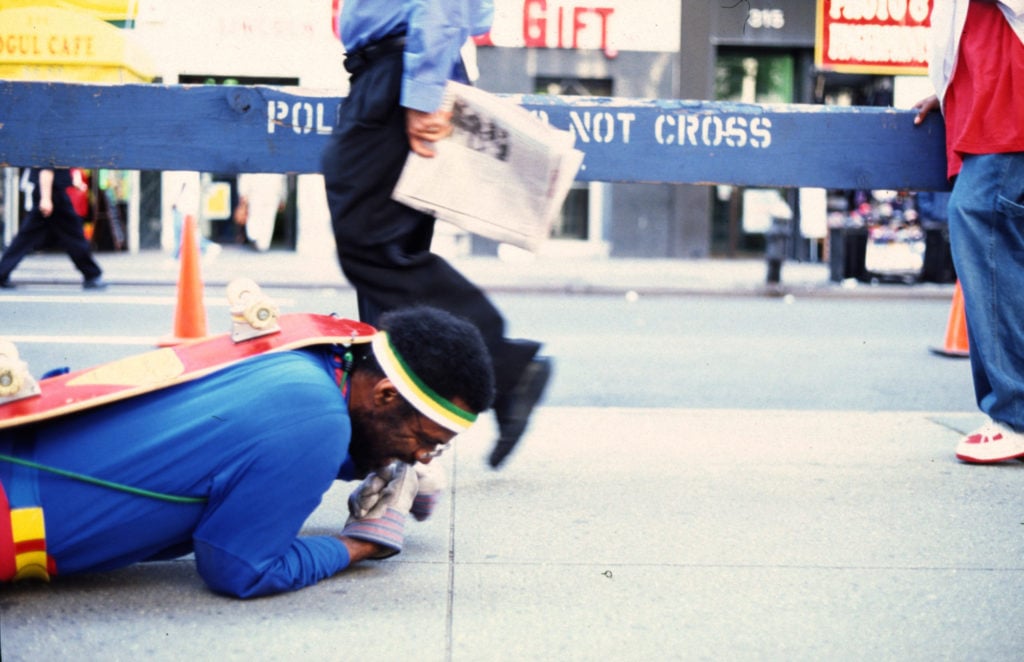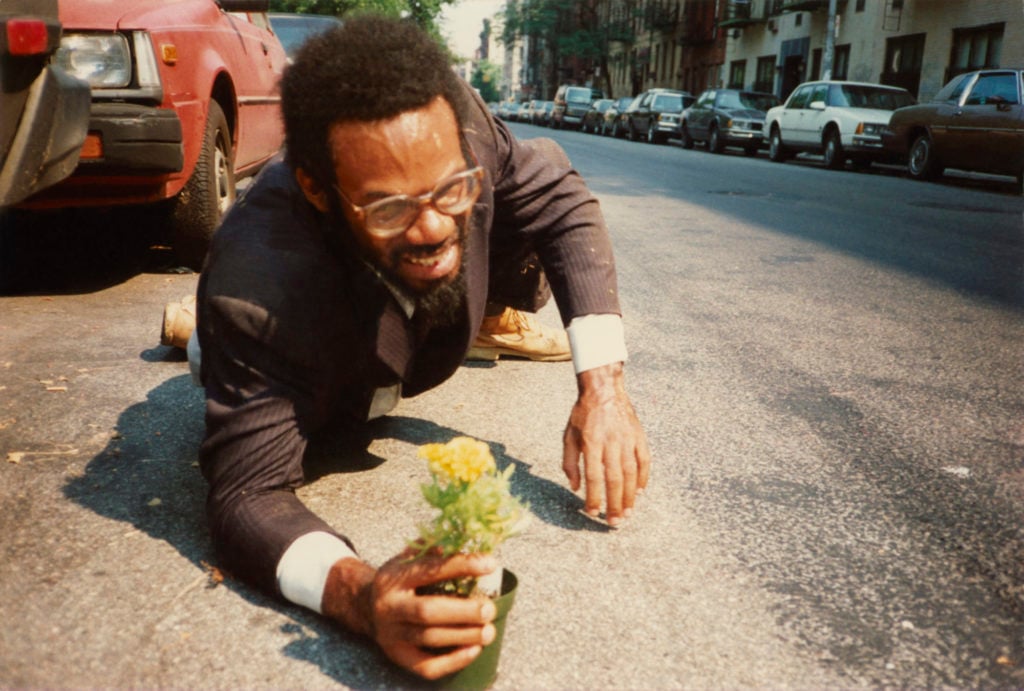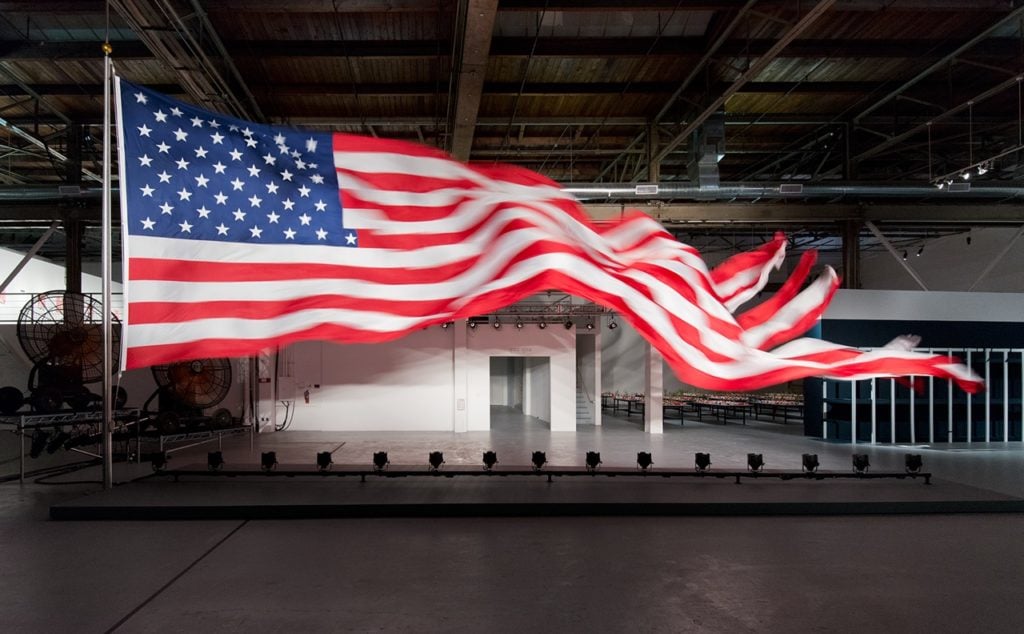People
Pope.L, the Performance Artist Who Confronted the Complexities of Race and Inequality, Has Died
The artist was 68.

The artist was 68.

Min Chen

William Pope.L, the performance and conceptual artist whose provocative works surfaced the complexities of race and class in America, has died aged 68.
His passing was announced by his gallery, Mitchell-Innes & Nash, which wrote in an Instagram post: “Pope.L fundamentally challenged and changed the last 50 years of visual art in the United States… His elegant, indeterminate, and often humorous, yet bitingly poignant criticism of our history has only recently begun to be fully recognized.”
Pope.L is best known for his endurance-based crawls, for which he dragged himself over long distances in performances that melded absurdism with activism. His most ambitious performance, The Great White Way: 22 Miles, 9 Years, 1 Street, which began in 2001, saw him belly-crawl from Broadway in Manhattan to his mother’s house in the Bronx while costumed in a Superman outfit, a skateboard strapped to his back. The journey took him nine years to complete.
For the artist, the crux of these works was less about the exploit than what it awoke within him—vulnerability, empathy, and what he described as “this marvelous creamy nougat center operating inside the performer.”
“Typically, the surface of the work becomes the life of the work,” he said in Interview in 2013. “Most folks only get the neatness of the feat. How many miles? How much pain? How many people said or did not say this or that? I am not interested in that.”

Pope. L, How Much is that Nigger in the Window a.k.a Tompkins Square Crawl, New York, 1991. © Pope. L. Courtesy of the artists and Mitchell–Innes & Nash, New York.
Pope.L was born William Pope in 1955 in Newark, New Jersey. His childhood was characterized by instability: “I’m very familiar with not having anything. Have-not-ness permeates everything I do,” he said in 1996. He recalled once living in an apartment on New York’s Lower East Side with holes in its walls, which his mother chose to plaster over with architectural plans of the building that she’d found. “I found that very ‘artistic,'” he said.
He would go on to graduate from Pratt Institute in 1975, before receiving his B.A. from Montclair State University and his MFA from the Mason Gross School of the Arts at Rutgers University in 1981. Around this time, while lecturing at Bates College in Maine, he adopted the moniker Pope.L, fusing his last name with his mother’s, Lancaster.
In the late ’70s, Pope.L commenced his series of crawl works, he told the Guardian, as “a way of doing anything I wanted that didn’t need anyone to support it.” For his first crawl in 1978, he donned a business suit and pulled himself across Times Square in New York, his ensemble and horizontal posture demonstrating the chasm, he said, between the “haves” and the “have-nots.”
In 1991, he crawled along the edges of Tompkins Square Park, then a site of violent encounters between squatters and police, while inexplicably pushing a potted plant, blending drollery with acute symbolism. That the piece was also titled How Much Is That Nigger in the Window, framed “as a jingle,” he said, added textual complexity (and complicity) to a bodily work.
“This language is a problem, but it’s also an interesting problem. How can I make these words approachable but not lose the sting of their character,” he said. “It is a writing problem, and it is a performing problem.”
Pope.L’s other interventions likewise confronted the nation’s seeing and unseeing of Blackness and poverty. Thunderbird Immolation (1978) saw him sit in a half-lotus pose atop a yellow meditation square in New York’s tony SoHo neighborhood. While surrounded by wooden matches, he periodically doused himself with Wild Irish Rose and Coca-Cola, a nod to the cheap wine marketed to poor inner-city neighborhoods as much as self-immolation.
In 2003, he began Black Factory, a project for which he solicited objects that “a person believes represents blackness,” amassing an archive not just of personal trinkets, but manifestations of prejudice. “We harvest all your confusions, questions and conundrums, and transform them into the greatest gift of all: possibility!” read the artist’s statement.

Installation view of William Pope.L, “Trinket,” 2015, at the Geffen Contemporary at MOCA. Photo Brian Forrest, courtesy the Museum of Contemporary Art, Los Angeles.
Over the past decade, Pope.L was increasingly embraced by institutions. He was included in the São Paulo Art Biennial in 2016, and in the Whitney Biennial and in Documenta in 2017. At the same time, his art lost none of its bite: in 2015, he installed a massive, frayed American flag, dotted with 51 stars, at the Geffen Contemporary in L.A. “I think there are cracks in the seams of what we are,” he said of the work, which the museum acquired earlier this year.
In 2019, a trio of activations across New York celebrated the artist’s expansive practice. The Museum of Modern Art, which acquired several of the artist’s performance works, staged the major retrospective “member“; Public Art Fund organized “Conquest,” a group crawl with 140 participants; and the Whitney Museum of American Art unveiled the sculptural installation Choir, which featured the artist’s text paintings.
“Today people often want art to have a clear and even redemptive political message, but Pope.L gave us neither,” Scott Rothkopf, director of the Whitney, told the New York Times. “He had a brilliant capacity to distill difficult, even horrifying truths about American society into strange and challenging work. It can be truculent, or funny, or both, but it’s never easy.”
Currently on view at the South London Gallery (through February 11, 2024) is “Pope.L: Hospital,” which opens on three large wooden towers that have collapsed on themselves. They recall the structure on which the artist perched for Eating the Wall Street Journal (2000), a live performance piece that involved him sitting on a toilet and consuming the broadsheet. The new wreckage, sans the performer, is blanketed in white dust; visitors are invited to sprinkle yet more dust on the work.
“I want to make things that are porous, that people can wrestle with or denigrate or yell at or laugh at or whatever the case may be,” Pope.L said in a video accompanying the show. “I always make them with an eye on the not-myself. I make stuff where the visitor [has] a role here… You come and fill the holes with your experience.”
More Trending Stories:
Art Dealers Christina and Emmanuel Di Donna on Their Special Holiday Rituals
Stefanie Heinze Paints Richly Ambiguous Worlds. Collectors Are Obsessed
Inspector Schachter Uncovers Allegations Regarding the Latest Art World Scandal—And It’s a Doozy
Archaeologists Call Foul on the Purported Discovery of a 27,000-Year-Old Pyramid
The Sprawling Legal Dispute Between Yves Bouvier and Dmitry Rybolovlev Is Finally Over